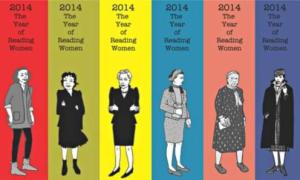
(Bookmarks by Joanna Walsh)
2014 has been designated the Year of Reading Women on a couple of fronts: Critical Flame journal has designated 2014 a year in which they will only read and publish in women writers and writers of colour; Joanna Walsh has started the #readwomen2014 campaign.
I am probably in an opposite situation to many readers out there: for the four years that my PhD lasted, I read books almost exclusively by Indian women (apart from a few scholarly books), so when I’d done with the PhD I promised myself that I would read a bit more broadly, including plenty of men!
But I’m aware that the literary and publishing establishment the world over still favours men, white men at that. Not always deliberately or consciously, but nevertheless (statistically speaking, anyway) books by women authors receive less attention than books by male authors.
Unlike the Critical Flame journal who got the ball rolling, and some other readers and bloggers out there, I’m not going to pledge to read more female authors of colour this year, because I really do think I read plenty–ie, the majority of what I read. But I read a good piece on the Arabic Literature (in English) blog recommending a book by an Arab woman author for every month of the year, as a way in for those readers who perhaps don’t know where to start.
So here are my recommendations for South Asian women’s books to read this year:
January: Manjushree Thapa’s The Tutor of History. I’m not of the opinion that women should always write exclusively about women, as even feminists of some persuasion do. Thapa writes cleverly and humorously about the political and social turmoil of contemporary Nepal, showing that women writers can have enormous breadth of experience and imagination.
February: Bapsi Sidhwa’s Ice-Candy Man/Cracking India. This Pakistani author’s fictionalised account of her experiences during the Partition of India in 1947 is published under two different titles. It is a brutal account of the horrors of communalism.
March: Anjum Hasan, Lunatic in My Head. This young author from India’s Northeastearn Meghalaya state wittily brings together small town and metropolitan India.
April: Mahasweta Devi, Breast Stories. You can’t go wrong with anything by Mahasweta Devi, but this powerful collection from the fierce Bengali author is a good place to start.
May: Yasmine Gooneratne, A Change of Skies. This Sri Lankan-Australian author wrote about the immigrant experience before Jhumpa Lahiri et al made it fashionable (one could even say passe…)
June: Sorayya Khan, Noor. Khan was one of, if not the first Pakistani English-language novelist to address (West) Pakistan’s crimes in East Pakistan/Bangladesh in 1971.
July: Anita Desai, Clear Light of Day or Baumgartner’s Bombay. This prolific Indian author has many short novels to her credit, and has been nominated for the Booker Prize several times, though she has never won. Her daughter, Kiran Desai, won the Booker in 2006 though, with The Inheritance of Loss. Many consider the mother the better writer, and these two suggestions, amongst her best loved, are good places to start.
August: Githa Hariharan, When Dreams Travel. Hariharan is also a prolific author, with many good novels. This recommendation is a retelling of the classic Thousand and One Nights.
September: Urvashi Butalia, The Other Side of Silence: Voices from the Partition of India. The only work of non-fiction to make this list, Butalia’s work of oral history is a stunning and groundbreaking work of feminist oral history.
October: Qurratulain Hyder, My Temples, Too. This Urdu-language Indian author translated her novels into English herself, which many critics say altered them enormously in the process. Several of her novels are sprawling histories, but the English translation of her first novel, My Temples, Too, about India’s Independence, is quite accessible.
November: Meena Kandasamy, Ms Militancy. The only collection of poetry to make this list (I don’t read much poetry), Kandasamy’s fierce anti-caste and anti-patriarchy poems live up to the collection’s name.
December: Arundhati Roy, The God of Small Things. If there’s one novel by a South Asian woman that the wider world is likely to have read, it is this Booker Prize winner. If you haven’t already, you can still fit it in in December!


